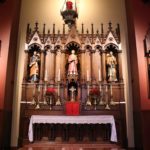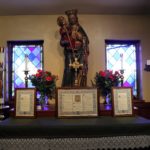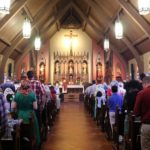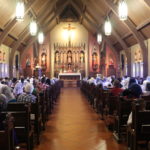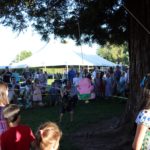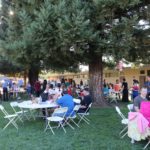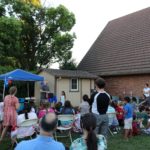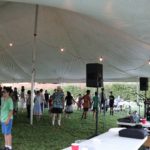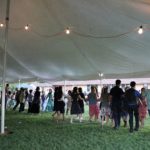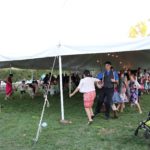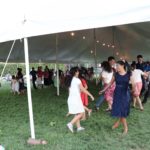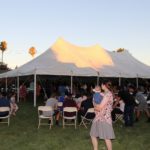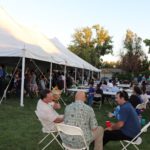On the Feast of Stephen

How do they do it?
It’s really the question you want to ask when you see the rather long list of things going on at St. Stephen the First Martyr Parish, our apostolate in Sacramento, California. St. Stephen’s was the final stop on the Missive’s summer California tour, and that weekend the busy parish was holding its biggest event of the year – the annual Pig Roast in honor of its patron saint.
One of the older parishes in the Fraternity, St. Stephen’s was founded in 1997 and worked out of the parishes of St. Rose and Immaculate Conception before purchasing its own church in 2002. The church was a former Lutheran building that required almost $2 million in initial renovations.
Even though it was smaller back then, the community was nonetheless very strong, said Fr. Joshua Curtis, who was appointed pastor of St. Stephen’s last year. They paid off the building in just a few years, and several sequential pastors built up the parish a step at a time. Fr. Lyons, who served as assistant for several years and then four more as pastor, brought them to the point they are at now, doing a tremendous amount of work on such projects as the parish hall and kitchen.
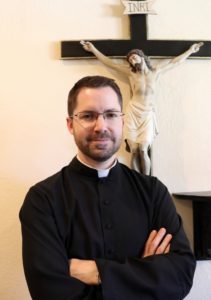
“Just rock solid,” said Fr. Curtis, describing the spirit of the former pastor, “and inexhaustible.” He would be up at 5 a.m., with the light on in his office till 9 p.m. “Day in, day out, absolutely steady.”
Fr. Lyons clearly left a huge legacy when he was appointed pastor of FSSP San Diego last summer, taking the place of Fr. Carl Gismondi who was assigned to head up our new parish in Philadelphia. But none was better equipped to take up the mantle than Fr. Curtis, who had already served for two years at St. Stephen’s as assistant pastor. And he had plenty of work before him, especially in regard to the pressing matter of their all-too-small church.

With an attendance of about 900 among the four Sunday Masses and a growth rate of 40-50 attendees per year, more space is badly needed, and plans are well afoot for expansion.
“It’s still just rough drafts at this point, but it’s been something we’ve been talking about for years,” Fr. Curtis explained. “Fr. Lyons and I started talking about it as soon as I got here, and started tossing around ideas, and sketching things just ourselves, brainstorming, thinking about difficulties.”
The goal is to at least double the capacity of the church. An architect is currently working on the official designs, with the central ideas being to add a narthex and expand seating into the wings and much further into the back. The parish hopes to eventually overhaul the sacristy and parish offices as well.
Despite the space issues, parish life goes on unabated. The number of educational and faith formation activities available for all ages are a testament to its particular character, which, among other epithets, could be described as, well, academic. The parish runs a high school co-op in which the priests teach the religion courses, including a one-year Old Testament course taught by assistant pastor Fr. Dominic Savoie and a one-year New Testament course taught by Fr. Curtis. Fr. Savoie teaches a course on faith and morality in which he goes through St. Thomas Aquinas’ Summa Theologiae in summary format, as well as popular adult formation classes, which have covered such works as the Book of Job, the Book of Genesis and the Office of the Dead. Fr. Savoie is a gifted teacher and possesses an in-depth familiarity with the Scriptures and the Church Fathers: if you read our Meménto newsletter, you have benefited from his vast supply of knowledge in our Ask Father column.
Fr. Curtis spoke with enthusiasm about the upcoming catechumenate program, a series of classes for those interested in coming into the Church. Up to this point, candidates for Baptism have met with a priest one-on-one for formation, but Fr. Curtis wanted to start something that was also accessible to parishioners and even people from other parishes who wished to deepen their knowledge of the Faith. Fr. Curtis further noted that one-on-one classes do not help the candidate plug into the life of the parish. According to the new plan, candidates will attend group classes twice a month and have a chance to meet each other and other parishioners, have refreshments and socialize for part of the time. Hence when it comes time for them to be baptized, they will already be well-integrated into the parish. Additionally, St. Stephen’s has permission to celebrate the pre-1955 Holy Week liturgy, which entails an earlier start time for the Easter Vigil and is more conducive to public baptisms than the later version. The candidates will therefore be baptized at the Vigil and welcomed into the Church and the parish in a public way.
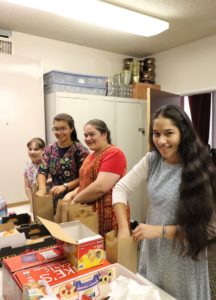
If we enumerated everything that’s going on at this lively hub of Fraternity life, this article would be reams long, so we’ll just touch on a few more activities. St. Stephen’s keeps up a number of charitable works, including participating in the Brown Bag Lunch program, an operation run out of the Sacramento Cathedral that involves giving out bagged lunches to the homeless of the area. St. Stephen’s is one of the parishes that provide the Cathedral with hundreds of bagged lunches, parishioners donating the food, putting together the lunches and transporting them to the Cathedral. A newly-founded chapter of the St. Vincent de Paul Society also assists the needy, processing and responding to requests for help that come to St. Stephen’s and giving the parish a reliable arm with which to handle these cases.
Now, we would be remiss if we didn’t mention the St. Stephen’s Bookstore, a place filled not only with a wide selection of Catholic reading material, sacramentals, medals and other gifts, but also with the joyful energy that seems to be a St. Stephen’s trademark. It’s a focal point for life at the parish, and though it really requires an article unto itself and we can’t do more than mention it here, we’ll be posting about it later on so stay tuned.
Of course, the whole reason we chose that weekend to visit St. Stephen’s was the annual Pig Roast, which is a part of the celebration of the feast day of their patron, St. Stephen the First Martyr. At this point you may be asking why they celebrate their patron on a date so distant from his liturgical feast day (if you don’t remember when that is, the words to a famous song will give you an idea: Good King Wenceslaus looked out, on the feast of Stephen, when the snow lay round about, deep and crisp and even…). Yes, it’s December 26th, not the best time for a parish party. When this happens, sometimes parishes can get permission to celebrate their patronal feast day at another time. Conveniently for St. Stephen’s, an old feast of his exists in August – the feast of the finding of his relics, which falls on August 3rd. They therefore celebrate their holy patron near that time.

The big day this year was Sunday, August 4th, and the High Mass, usually at 10:30 a.m., was moved to the 1:30 p.m. time slot so as to sync with the rest of the day’s events. The Mass was that of the External Solemnity of St. Stephen, and the crowds filled the church. At 3:30 p.m., Vespers were sung and at 5 p.m., dinner began. Families and friends lined up to partake of the smorgasbord set up inside the parish hall, a spacious, high-ceilinged building, once a gym, that provides abundant space for parish events. The fare included, yes, you guessed it, roast pig, along with a variety of other treats including hamburgers, chili, mac & cheese, salad and watermelon.
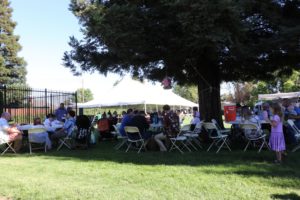
The partygoers bore their plates of victuals outside and gathered at tables under the boughs of trees or in the shade of a great tent set up on the grassy expanse that lies beyond the main parish complex, trayfuls of ice cream making their way around the crowds as dinner was concluding. The children enjoyed face-painting, a magic show, sno cones, taking swings at piñatas hung from one of the trees and, of course, dogpiling on the candy that eventually rained down. The tables were moved out from under the tent after dinner and square dancing, complete with a live band, took their place.
So, if you find yourself in northern California around the beginning of August, we highly recommend joining St. Stephen’s for their yearly festivities. But as you can tell, there really isn’t a bad time to visit. All year round it is a glowing example of that comprehensive parish life that the Fraternity strives to provide as an important complement to the Holy Mass and the Sacraments. Friendships, education, faith formation, charitable work, evangelization and recreation are all critical components to a well-balanced Catholic life, and the parish in California’s capital city does it all. +
November 8, 2019


